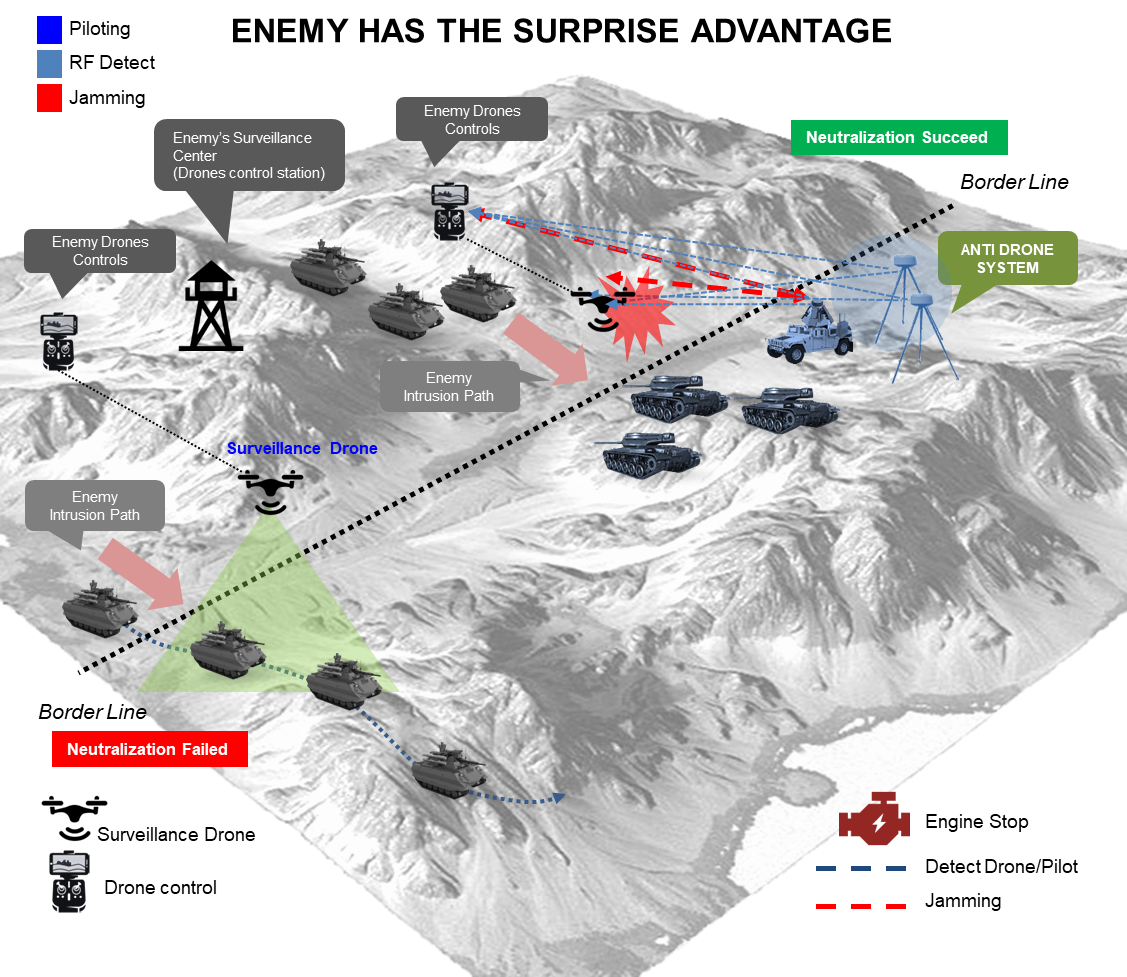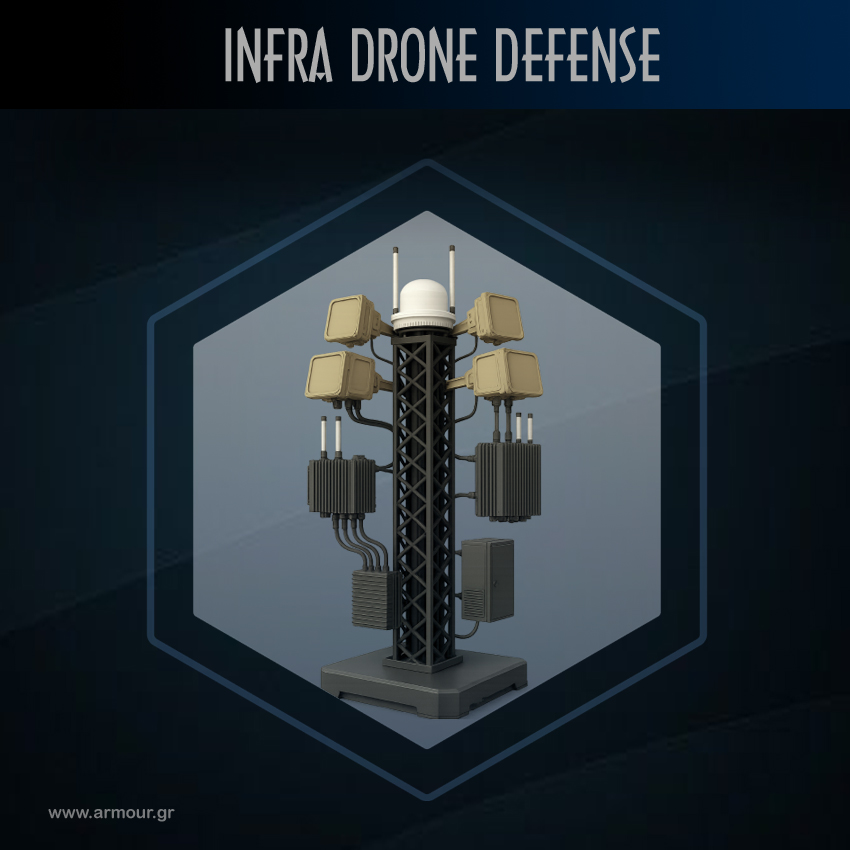
Understanding Anti-Drone Systems
From Small UAVs to Large Military Drones
In an era where drones and UAVs (Unmanned Aerial Vehicles) have become pivotal in both civilian and military applications, the need for effective anti-drone systems has dramatically increased.
These systems are designed to detect, track, and neutralize unmanned aircraft that pose a threat to security, privacy, or safety. From portable systems designed for small drones to sophisticated setups for taking down large military drones, the range of anti-drone technologies is broad and diverse.
1. Portable Anti-Drone Systems
Portable or tactical anti-drone systems are lightweight and designed for mobile use, making them ideal for protecting individuals, small areas, or mobile units from smaller drones.
These systems often utilize radio frequency (RF) jamming techniques to disrupt the communication between a drone and its controller.
An example of this is the DroneGun, which can force a drone to land or return to its starting point by jamming its signals.
Functionality: These systems are typically handheld or backpack-mounted devices that disrupt the communication and navigation signals of a drone. They work by jamming the radio, GPS, and sometimes even ISM frequencies, forcing the drone to either land or return to its point of origin. Advantages: Highly mobile and easy to operate, making them ideal for personal security or small unit military applications where flexibility is paramount. Limitations: Limited range and often only effective against drones that rely on direct communication links. They may not work on autonomous drones that do not require a constant link back to their operator.
2. Fixed Installation Systems
For the protection of larger areas such as airports, prisons, or critical infrastructure, fixed anti-drone systems are installed. These systems combine radar detection with advanced algorithms to identify drone threats across wide areas.
Once a threat is detected, methods like RF jamming, spoofing (sending false GPS coordinates to drones), or laser-based systems can be employed to neutralize the drone.
Functionality: These systems use a combination of radar, cameras, and other sensors to detect and identify drones over a large area. Once a drone is detected, fixed systems can employ various countermeasures, including jamming, spoofing, or even directed energy weapons. Advantages: Capable of covering large areas continuously, with some systems able to protect entire facilities. Limitations: These systems are expensive and require significant infrastructure and maintenance. They also have fixed positions, which could be bypassed or avoided by a determined adversary.
3. Laser Systems
Laser weapons provide a more aggressive approach to drone defense, capable of disabling drones at considerable distances almost instantly. These systems use high-energy lasers to damage or destroy drones in flight. The U.S. Navy, for example, has deployed the LaWS (Laser Weapon System) on its ships, which can be used against both aerial and maritime threats.
Functionality: Laser systems target drones with a highly concentrated beam of light that can heat and disable the drone's components or ignite flammable parts. Advantages: Very fast response time and precise targeting capabilities, which minimize collateral damage. Limitations: Weather and atmospheric conditions can greatly affect performance. High costs and significant power requirements also limit deployment options.
4. Electromagnetic Pulse (EMP) Systems
EMP systems are designed to emit a strong electromagnetic pulse that can disable all electronic components within the drone. These systems can effectively neutralize multiple drones simultaneously without causing physical damage to the surrounding environment. However, the use of EMP poses risks to other electronic systems in the area, requiring careful operational planning.
Functionality: These systems generate a short, high-energy pulse of electromagnetic energy that can disrupt or damage electronic circuits within the drone. Advantages: Effective against swarms of drones due to their area-of-effect nature. Limitations: Can affect other electronics not targeted by the pulse, requiring careful consideration of the operational environment. Also, generating EMP requires large amounts of energy.
5. Net Capture Systems
Some anti-drone strategies involve physically capturing drones using nets. These nets can be launched by other drones, ground-based systems, or even manually. After ensnaring the drone, the net can bring it to the ground safely, which is particularly useful when the goal is to analyze the drone for forensic purposes.
Functionality: These systems launch a net to physically capture and bring down a drone. Nets can be launched from other drones, ground installations, or even manually. Advantages: Non-destructive method that allows for drone recovery and forensic analysis. Limitations: Limited range and accuracy. Effective only against smaller, slower-moving drones.
6. Acoustic Systems
Acoustic systems detect drones based on the noise they generate. These systems are less intrusive and can be used in environments where RF jamming is inappropriate. They are particularly useful for early detection and are often paired with other anti-drone technologies to enhance overall effectiveness.
Functionality: These systems use arrays of microphones to detect the unique sound signatures of drones. Advantages: Non-intrusive and can be used in environments where RF interference is a concern, such as near airports or urban areas. Limitations: Limited range and effectiveness can be reduced by background noise. Generally used only for detection, requiring integration with other countermeasures for interception.
7. Geo-Fencing
Geo-fencing is a preventative measure more than an active anti-drone system. It involves setting up virtual perimeters that drones cannot cross. Most commercial drones are already programmed to recognize and respect geo-fences around restricted areas like airports.
Functionality: Involves creating virtual perimeters that drones cannot enter. This is often implemented in the drone's software, preventing it from entering certain GPS coordinates. Advantages: Preventative measure that automatically enforces no-fly zones without human intervention. Limitations: Dependent on compliance by drone manufacturers and can be bypassed by modifying the drone’s software or using drones not equipped with geo-fencing technology.
8. Hybrid Systems
Hybrid systems integrate multiple technologies to create a comprehensive defense solution. For example, combining radar, optical, and acoustic sensors can cover more bases, which is essential in high-security areas where drones might employ various technologies to evade single-method detection systems.
Functionality: These systems combine multiple detection and neutralization technologies to create a layered defense solution. Advantages: By integrating various technologies, these systems can cover more scenarios and are more adaptable to different threats. Limitations: Complexity and cost can increase significantly with the integration of multiple technologies. Coordination and management of different systems also pose operational challenges.
Each type of anti-drone system offers unique capabilities and serves different operational needs, from individual protection to safeguarding sensitive installations.
The choice of system depends largely on the specific threat profile, operational requirements, and environmental factors.
As the airspace becomes increasingly crowded with drones of various sizes and capabilities, the development and deployment of robust anti-drone systems continue to evolve.
The diversity of these systems ensures that they can cater to different environments and threats, from small, commercially available drones to large, military-grade UAVs.
For military applications, the emphasis is on reliability and robustness, while civilian systems prioritize safety and non-intrusiveness.
As technology advances, these systems will undoubtedly become more sophisticated, offering tighter security against the growing drone threat.







